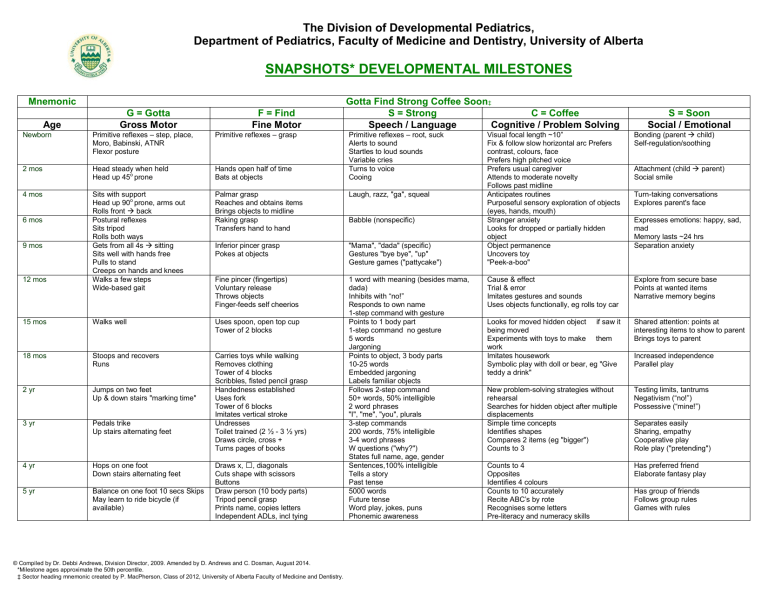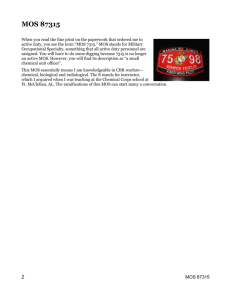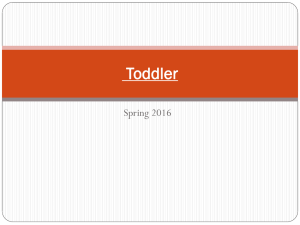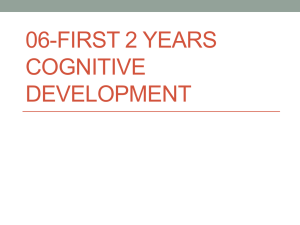Developmental Milestones Reference Chart1

The Division of Developmental Pediatrics,
Department of Pediatrics, Faculty of Medicine and Dentistry, University of Alberta
SNAPSHOTS* DEVELOPMENTAL MILESTONES
Mnemonic
Newborn
2 mos
4 mos
6 mos
9 mos
12 mos
15 mos
18 mos
2 yr
3 yr
4 yr
5 yr
Age
G = Gotta
Gross Motor
Primitive reflexes – step, place,
Moro, Babinski, ATNR
Flexor posture
Head steady when held
Head up 45 o prone
F = Find
Fine Motor
Primitive reflexes – grasp
Sits with support
Head up 90
Sits tripod o prone, arms out
Rolls front back
Postural reflexes
Rolls both ways
Gets from all 4s sitting
Sits well with hands free
Pulls to stand
Creeps on hands and knees
Walks a few steps
Wide-based gait
Hands open half of time
Bats at objects
Palmar grasp
Reaches and obtains items
Brings objects to midline
Raking grasp
Transfers hand to hand
Inferior pincer grasp
Pokes at objects
Fine pincer (fingertips)
Voluntary release
Throws objects
Finger-feeds self cheerios
Walks well Uses spoon, open top cup
Tower of 2 blocks
Stoops and recovers
Runs
Jumps on two feet
Up & down stairs "marking time"
Pedals trike
Up stairs alternating feet
Hops on one foot
Down stairs alternating feet
Balance on one foot 10 secs Skips
May learn to ride bicycle (if available)
Carries toys while walking
Removes clothing
Tower of 4 blocks
Scribbles, fisted pencil grasp
Handedness established
Uses fork
Tower of 6 blocks
Imitates vertical stroke
Undresses
Toilet trained (2 ½ - 3 ½ yrs)
Draws circle, cross +
Turns pages of books
Draws x,
, diagonals
Cuts shape with scissors
Buttons
Draw person (10 body parts)
Tripod pencil grasp
Prints name, copies letters
Independent ADLs, incl tying
© Compiled by Dr. Debbi Andrews, Division Director, 2009. Amended by D. Andrews and C. Dosman, August 2014.
*Milestone ages approximate the 50th percentile.
‡ Sector heading mnemonic created by P. MacPherson, Class of 2012, University of Alberta Faculty of Medicine and Dentistry.
Gotta Find Strong Coffee Soon
‡
S = Strong
Speech / Language
C = Coffee
Cognitive / Problem Solving
Primitive reflexes – root, suck
Alerts to sound
Startles to loud sounds
Variable cries
Turns to voice
Cooing
Laugh, razz, "ga", squeal
Babble (nonspecific)
"Mama", "dada" (specific)
Gestures "bye bye", "up"
Gesture games ("pattycake")
Visual focal length ~10”
Fix & follow slow horizontal arc Prefers contrast, colours, face
Prefers high pitched voice
Prefers usual caregiver
Attends to moderate novelty
Follows past midline
Anticipates routines
Purposeful sensory exploration of objects
(eyes, hands, mouth)
Stranger anxiety
Looks for dropped or partially hidden object
Object permanence
Uncovers toy
"Peek-a-boo"
1 word with meaning (besides mama, dada)
Inhibits with “no!”
Responds to own name
1-step command with gesture
Points to 1 body part
1-step command no gesture
5 words
Jargoning
Points to object, 3 body parts
10-25 words
Embedded jargoning
Labels familiar objects
Follows 2-step command
50+ words, 50% intelligible
2 word phrases
"I", "me", "you", plurals
3-step commands
200 words, 75% intelligible
3-4 word phrases
W questions ("why?")
States full name, age, gender
Sentences,100% intelligible
Tells a story
Past tense
5000 words
Future tense
Word play, jokes, puns
Phonemic awareness
Cause & effect
Trial & error
Imitates gestures and sounds
Uses objects functionally, eg rolls toy car
Looks for moved hidden object if saw it being moved
Experiments with toys to make them work
Imitates housework
Symbolic play with doll or bear, eg "Give teddy a drink"
New problem-solving strategies without rehearsal
Searches for hidden object after multiple displacements
Simple time concepts
Identifies shapes
Compares 2 items (eg "bigger")
Counts to 3
Counts to 4
Opposites
Identifies 4 colours
Counts to 10 accurately
Recite ABC’s by rote
Recognises some letters
Pre-literacy and numeracy skills
S = Soon
Social / Emotional
Bonding (parent child)
Self-regulation/soothing
Attachment (child parent)
Social smile
Turn-taking conversations
Explores parent's face
Expresses emotions: happy, sad, mad
Memory lasts ~24 hrs
Separation anxiety
Explore from secure base
Points at wanted items
Narrative memory begins
Shared attention: points at interesting items to show to parent
Brings toys to parent
Increased independence
Parallel play
Testing limits, tantrums
Negativism (“no!”)
Possessive (“mine!”)
Separates easily
Sharing, empathy
Cooperative play
Role play ("pretending")
Has preferred friend
Elaborate fantasy play
Has group of friends
Follows group rules
Games with rules
Sector
Domains/ skills/processes
Trends
Examples of devt’l disorder in sector
Gross Motor
Posture
Change of position
Ambulation
Strength
Balance
Coordination
Primitive reflexes to volitional movement
Cephalo-caudal
Proximal to distal
Flexor to extensor
Postural reflexes fade as balance increases
Single mvts to sequences
Effortful to automatic
Cerebral palsy
Muscular dystrophies
DCD
Examples of adult functional loss in sector
Adult disability
(mostly based on loss of previously normal function, per Canada
Revenue )
Vision : acuity in both eyes 20/200
(6/60) or less OR greatest diameter of field of vision in both eyes is 20 degrees or less.
Who assesses
Paresis/paralysis
Walking
"unable to walk even with approp. therapy, medication & devices; OR requires an inordinate amount of time to walk, even with approp. therapy, medication & devices"
MD
PT
RED FLAGS!
REGRESSION
(loss of skills) &
PARENTAL
CONCERN are red flags at any age
Persistent primitive reflexes
Abnl tone or mvt patterns at any age, spasticity, hypotonia, absent
DTRs
Asymmetry
Poor head control at 5 mos
Not sitting independently with hands-free at 8 mos
Not rolling back-front, not taking weight well through the legs when held at 9 mos
Not walking by 18 mos
Fine Motor
Tool use
Dexterity
Precision
Bi-manual coordination
Development: trends, delays and disabilities
Speech / Language
Communication
Words and symbols (semantics)
Grammar (syntax)
Pragmatics
Articulation/voice/fluency
Cognitive / Problem Solving
Intellect
Thinking
Remembering
Categorising
Problem-solving
Analysis/synthesis
Primitive reflexes to volitional movement (grasp)
Proximal to distal (whole hand to fingertips)
Effortful to automatic
Unilateral to bimanual coordination
DCD
Dysgraphia
Paresis/paralysis
Apraxia
Primitive reflexes to volitional movement (suck)
Proximal to distal (back of throat to lips, tongue, teeth)
Understanding before speaking (rec before exp)
Inc'ing length of utterance
Inc'ing complexity of syntax
“Metas”
Devt’l language disorders
Language-based learning disability (dyslexia)
Dysarthria/Stuttering
Aphasias
Feeding
Dressing
Elimination (toileting req'd for bowel or bladder functions)
"unable to do task even with approp. therapy, medication & devices; OR requires an inordinate amount of time to do task, even with approp. therapy, medication & devices"
Speaking
Hearing
"unable to speak/understand even with approp. therapy, medication & devices; or requires an inordinate amount of time to speak/understand, even with approp. therapy, medication & devices" (hearing specifies "in a quiet setting")
MD
OT
Lack of transfer at 7 mos
Using one hand exclusively at any age
Delayed self care (ADLs) at 4 years
Delayed printing at school entry
Implicit memory before explicit
Specific>general>specific
Increased # of dimensions attended to simultaneously
"Trial & error" to mental rehearsal
Concrete (sensory, hands-on) to abstract
Inc'd use of executive functions
Inc'd length of attention span
“Metas”
Mental retardation (intellectual impairment)
Learning Disabilities
Dementia
Specific stroke syndromes
"Mental functions" =
-Adaptive functioning (eg self-care, health & safety, social skills common, simple transactions)
-Memory
-Problem-solving, goal-setting, and judgment
"unable to perform mental functions* even with approp. therapy, medication & devices;
OR requires an inordinate amount of time to do task, even with approp. therapy, medication & devices"
Social / Emotional
Self-awareness
Empathy
Relationships
Emotional regulation
Bonding: parent>child
Attachment: child >parent
Increasing social circle: self
>primary caregiver >extended family >peers >broader community >country & culture
>world
Autism spectrum disorders
Reactive attachment disorder
Mental health disorders
Post concussion personality changes
Adaptive functioning (eg selfcare, social skills
"unable to perform mental functions* even with approp. therapy, medication & devices;
OR requires an inordinate amount of time to do task, even with approp. therapy, medication
& devices"
MD
SLP
Audiologist
Problems with feeding and/or swallowing
Parents suspect hearing loss, babbling stops at > 6 mos, lack of response to sound (check hearing!)
No single words by 15 mos
No combos by 24 mos
Stutter past 3 ½ yrs (or earlier if anxiety/mannerisms)
Idiosyncratic speech, disordered sequence of development
Poor intelligibility for age
MD
Psychologist
Optometrist or Ophthalmologist
Lack of developmentally appropriate response to visual stimuli
Immature play (like younger child)
Stereotypic play; lack of pretend
School failure (either for specific subjects like reading or math or generalised)
Always check vision and hearing if any concerns—can be assessed as young as newborn
MD
Psychologist
Mental health therapist
Emotional dysregulation
Abnormal attachment patterns
(over-clingy, indiscriminate)
Limited social smiling and shared enjoyment by 6 mos
Limited gestures like pointing, response to name, joint attention by 12 mos
Limited social imitative play by 18 mos (eg imitating housework)
Limited pretend play (eg feeding doll) by 24 mos
No friends at school-age
© Compiled by Dr. Debbi Andrews, Division Director, 2009. Amended by D. Andrews and C. Dosman, August 2014.
*Milestone ages approximate the 50th percentile.
‡ Sector heading mnemonic created by P. MacPherson, Class of 2012, University of Alberta Faculty of Medicine and Dentistry.


